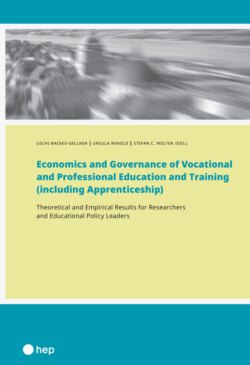Оглавление
Uschi Backes-Gellner. Economics and Governance of Vocational and Professional Education and Training (including Apprenticeship) (E-Book)
Chapter 1: Introduction
Acknowledgments
References
Chapter 2: Socially Constructed Concepts—Methodological Problems in Comparing VET Programs
Preface
2.1Introduction
2.2Social Constructs of What?
2.3Socially Constructed Economy
2.3.1Adam Smith and Friedrich List and Rival Concepts
Division of Labor
Narrow versus Broad Skills Set
Short-Term versus Long-Term Views
Governance and Configuration of National Institutions
2.3.2Concept of Variety of Capitalism (VoC)
2.4Methodological Problems of Definitions. 2.4.1Problems of Definitions
2.4.2Classification Scheme for VET Programs
2.4.3Forms of Construct Metaphors
2.5Functional Equivalents
2.5.1Functional Equivalents in Different Scientific Disciplines
2.5.2Static versus Dynamic Functions
2.6Conclusions
2.7References
Chapter 3: Firms. Chapter Preview of Reprints
The Role of Firms in VET
Extensions of Classical Human Capital Theory
Where We Started
Our Research Contributions to the Topic of Firms
Net Costs or Net Benefits?
Poaching as a Threat to Training Activities?
Make or Buy Decisions
Firms and Individuals as Beneficiaries of VET
References
3.1Net Costs of Training Apprentices and the Willingness to Train
Gross Costs, Benefits, and Net Costs of Training for Training and Non-Training Firms
Policy Recommendations
3.2The Number of Competitors Increases the Net Costs of Training Apprentices
Policy Recommendations
3.3Net Costs of Training Apprentices in Different Systems
Policy Recommendations
3.4Employers’ Strategies to Apprenticeship Training: Investment or Production
Policy Recommendations
3.5The Willingness to Train for Companies with Net Costs is Slowed Down by Poaching
Policy Recommendations
3.6Retaining Apprenticeship Graduates
Policy Recommendations
3.7Net Costs, Hiring Costs, and the Willingness to Train
Policy Recommendations
3.8University Graduates Profit from Working Together with VET Graduates
Policy Recommendation
3.9Avoiding Labor Shortages by Improving Recruitment Success Through Apprenticeship Training
Policy Recommendations
3.10How Firms’ Participation in Apprenticeship Training Contributes to Innovation
Policy Recommendation
3.11How Does Diversity of Employees in Terms of Formal Education Degrees Affect Firm Innovation?
Policy Recommendations
3.12Ongoing Research Firms
Comparative Studies and Studies Beyond the German-Speaking Countries
Post-Training Benefits
Framework Conditions and the Propensity of Firms to Train
VET and Innovation
VET and the Skill Mix of Firms
Simulating Cost and Benefits in Other Countries
References
Chapter 4: Individuals. Chapter Preview of Reprints
Occupational Choice Decisions before the Start of an Apprenticeship or VET Path
Individual Decisions during a VET Program
Short-Term Outcomes after VET: Transitions into the Labor Market
Long-Term Labor Market Outcomes
Specificity of VET Occupations and Labor Market Outcomes
References
4.1Recruitment Decision of Firms
Policy Recommendations
4.2Learning for a Bonus in Vocational Education and Training
Policy Recommendations
4.3Transition from Vocational Education and Training into the Labor Market
Policy Recommendations
4.4Vocational Versus Academic Tertiary Education
Policy Recommendations
4.5Why Permeability Counts?
Policy Recommendations
4.6Are the Returns to Education the Same for Everyone? A Look at Wage Distribution
Policy Recommendations
4.7Specificity of VET Occupations and Mobility
Policy Recommendations
4.8Occupational Mobility Within and Between Clusters of Occupations
Policy Recommendations
References
4.9Specific Occupations Promise Higher Wages When Staying, While General Occupations Enhance Occupational Mobility
Policy Recommendations
References
4.10When Skills Lose Value over Time: Workplace Tasks and Skill Obsolescence
Policy Recommendations
4.11Ongoing Research Individuals
Occupational Choice Decisions before VET Starts
Individual Outcomes during and immediately after VET
Long-Term Labor Market Outcomes after VET
References
Chapter 5: State and Institutional Frameworks. Chapter Preview of Reprints
Foundations of Education Systems
The Role of the State and the Institutional Framework in VPET
Research Contributions to Understanding the Role of the State and Its Institutional Framework
References
5.1How Can Scholars Develop an Explanatory Typology of VET Programs?
Policy Recommendations
5.2KOF EELI: Measuring Education-Employment Linkage
Policy Recommendations
5.3Which Skills Can Best be Learned in the Workplace?
Learning from different role models
Policy Recommendations
5.4Labor Market Regulation and Its Impact on Apprenticeship Training
Policy Recommendations
5.5Labor Market Deregulation and Its Impact on Apprenticeship Training
Policy Recommendations
5.6Policy Preferences of Voters Concerning Academic vs. Vocational Education
Policy Recommendations
5.7Is Vocational Education and Training Only the First Choice for Those Rooted in Such a System?
Policy Recommendations
5.8State Interventions to Promote Vocational Education and Training
Policy Recommendations
5.9Ongoing Research State and Institutional Frameworks
Functions, Governance, and Social Institutions of VET
VPET Systems and System Engineering
Implementation
Evaluation, Monitoring, and Key Outcomes
References
Chapter 6: Monitoring the Youth Labour Market Situation Around the Globe. Insights from the first five releases of the KOF Youth Labor Market Index[17]
Preface
6.1Introduction
6.2The Design of the KOF YLMI
Review of Existing Labor Market Indicators
6.2.1Dimensions and Indicators of the KOF YLMI
Activity State
Working Conditions
Education
Transition Smoothness
6.2.2Data and Methodology of the KOF YLMI
Data Sources
Calculation Methods
6.3Applications of the KOF YLMI
6.3.1The Youth Labor Market Situation during the Great Recession
A General Overview
A Comparison between the EU and the US
6.3.2Country-Specific Analyses Based on the KOF YLMI. The Polarized Context of Greece
How Ireland Overcame the Crisis
6.3.3Where Does the Great Recession Most Affect the Working Conditions?
6.3.4The Relationship between Activity State and the Formal Education and Training Rate
YLMI Best-Performers at Comparison
Do Leaders in PISA Test Perform Better?
6.3.5Disentangling the Skills Mismatch Rate
Definition and Description of Skills Mismatch
Skills Mismatch Patterns
6.4Lessons Learned and Outlook
Bibliography
Appendix A: Glossary
Appendix B: Further Readings on PVET
